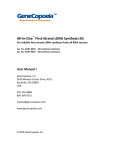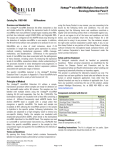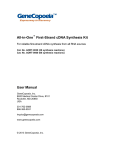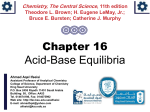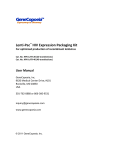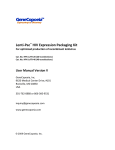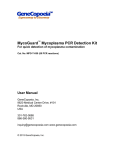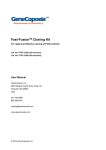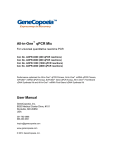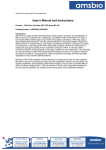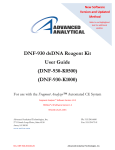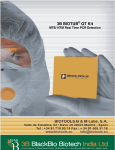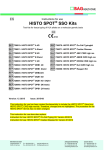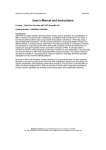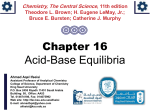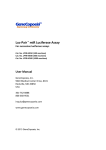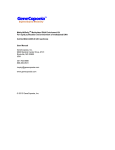Download HmiRQP0002 hsmq0104
Transcript
TM G en eCopoeia Expressw ay to Discovery All-in-One™ miRNA qPCR Primer Catalog number: : HmiRQP0002 User Manual and Primer Validation Report GeneCopoeia, Inc. 9620 Medical Center Drive, #101 Rockville, MD 20850 USA 301-762-0888 866-360-9531 [email protected] www.genecopoeia.com © 2009 GeneCopoeia, Inc. All-in-One™ miRNA qPCR Primer Manual and Validation Report Primer Manual and Validation Report I. Introduction II. Product Information III. Additional Materials Required or Recommended IV. Procedure V. Storage VI. Applications VII. All-in-One miRNA qPCR primer validation report VIII. Limited Use License and Warranty I. Introduction miRNAs are single-stranded non-coding RNA molecules that are on average about 22 nucleotides in length that regulate gene expression and thereby regulate different physiological activity in the cell. However, they are difficult to detect due to their short lengths. All-in-One miRNA qPCR primers are specific miRNA upstream detection primers for qPCR. When combined with the GeneCopoeia All-in-One miRNA qRT-PCR Detection Kit, the primers can be used for miRNA quantitation. GeneCopoeia All-in-One miRNA qPCR primers have been validated in qPCR reactions using their specific cDNAs as templates. II. Product Information Package PCR Catalog# Primer ID Mature_Acc Mature_ID size Conc. size HmiRQP0002 hsmq-0104 MIMAT0000062 hsa-let-7a 75bp 100 µM 500 rxn 10× Mix 3 rxn HmiRQT0001 Positive Control cDNA Mix III. Additional Materials Required or Recommended GeneCopoeia All-in-One™ miRNA qRT-PCR Detection Kit (Cat Nos. AOMD-Q020 or AOMD-Q050) 2 All-in-One™ miRNA qPCR Primer Manual and Validation Report IV. Procedure 1. Upon receiving centrifuge the tubes at 12,000 rpm for 30 seconds so that the liquid stays at the bottom of the tubes. 2. The primers are dissolved in TE (10mM Tris-Cl, 1mM EDTA). The concentration of each primer is 100 µM. Dilute the primers to the concentration of 2 µM with sterilized ddH2O before use. 3. For each reaction, take one of the primers and add it to a PCR primer reaction tube (2 µl primer for 20 µl reaction). The final working concentration of the primer should be 0.2 µM. The products are used together with the All-in-One miRNA qRT-PCR Detection Kit. For details, refer to the appendix of primer-specific All-in-One miRNA qPCR Validation Report, Part B, Procedure, Section “qPCR to detect miRNA”. 4. The primers are provided with a positive control cDNA mix for use as templates for validation. The quality of the primers may be validated with the method described in the appendix of primer-specific All-in-One miRNA qPCR Validation Report, Part B, Procedure, Section “qPCR to detect miRNA”. 5. These primers should be used with a miRNA Poly (A) tailing kit. It is not suitable for use with a ® TaqMan miRNA detection kit. 6. The positive control cDNA mix is synthesized with the All-in-One miRNA qRT-PCR Detection kit which uses a uniquely designed oligo-dT adaptor as the reverse transcription primer and a universal reverse qPCR primer that specifically matches to the oligo-dT adaptor. The mix cannot be used in conjunction with other miRNA Poly (A) tailing kits to validate the All-in-One miRNA qPCR primer. V. Storage Store in -20°C and avoid repeated freeze-thaw cycles . VI. Applications All-in-One miRNA qPCR Primers are used for detection of miRNA expression. When combined with the All-in-One miRNA qRT-PCR Detection Kit the primers can be used to detect miRNAs both qualitatively and quantitatively. VII. All-in-One miRNA qPCR Primer Validation Report A. Materials and Methods 1. Instrument iQ5 Real Time PCR Detection System: Bio-Rad 2. Reagents ™ All-in-One miRNA qRT-PCR Detection Kit (Catalog Nos. AOMD-Q020 or AOMD-Q050) Validation templates: cDNAs extracted from 10 different human tissues 3 All-in-One™ miRNA qPCR Primer Manual and Validation Report B. Procedure RNA Extraction 1. Sample preparation Place a small amount of material from a human tissue sample into a pre-cooled mortar. Add a small amount of liquid nitrogen and grind the tissue to a fine powder. Transfer the powder to a centrifuge tube containing 1 ml of TRIzol (Invitrogen). Vortex for 5 minutes. (If the samples are cultured cells, use about 6 7 10 ~10 cells with 1 ml of TRIzol). Pipette up and down until the cells are completely lysed). 2. Phase separation Leave the cell or tissue samples at room temperature for about 10 minutes. Add 200 µl of chloroform per 1 ml of TRIzol. Close the cap and vortex vigorously for 1 minute. Let the samples settle down at room temperature for 2-5 minutes. Centrifuge at 12,000 g for 15 minutes at 6°C. Remove tubes from the centrifuge being careful not to disturb the liquid. The samples should be separated into 3 layers with RNA in the top layer. 3. RNA Precipitation Carefully transfer about 450 µl (per 1 ml TRIzol) of the supernatant to a new centrifuge tube containing 600 µl of cold 2-propanol. Mix well and keep at –20°C fo r 10 minutes. Then centrifuge at 12,000 g for 10 minutes (at 6°C). 4. Washing Remove the supernatant. Add 500 µl of cold 75% ethanol. Vortex until a pellet forms at the bottom of the tube. Centrifuge at 12,000 g for 5 minutes (6°C). Remove the supernatant. Centr ifuge briefly again and remove the remaining supernatant. 5. Dissolve RNA Air-dry the samples for 5 to 10 minutes. (Do not over dry the samples. The samples are dry when they turn white). Dissolve the samples in 30 µl of DEPC water. Label the samples properly and store them at –80°C. 6. Determine RNA Concentration Take 1 µl of RNA sample. Dilute the sample 1:10 in DEPC water. RNA concentration can be measured with a NanoDrop (Thermo Scientific). DEPC water should be used as a blank. Record both the RNA concentration and the ratio of A260/A280. 4 All-in-One™ miRNA qPCR Primer Manual and Validation Report 7. RNA electrophoresis 7.1.Prepare denaturing gel Add 1 g of agarose into 75 ml of de-ionized water. Boil the agarose for 1–2 minutes and cool it down to about 70°C. Add 10 ml of 10X MOPS, 15 ml of f ormaldehyde and 5 µl of ethidium bromide (EB). Pour the gel into a tray with big combs. Cover the tray. 7.2.Prepare electrophoresis buffer (1X MOPS) Take 50 ml of 10X MOPS and dilute 1:10 to the final volume of 500 ml with de-ionized water. Pour the buffer into a gel box, and add some EB to it. 7.3.Preparation of RNA sample Take 3 µl of the RNA sample and add DEPC to a total volume of 18 µl. Heat the sample at 65°C for 10 minutes. Cool it down immediately. Add 2 µl of 1X RNA loading buffer into the sample. 7.4.RNA electrophoresis Place the RNA gel in a gel box with 1X MOPS electrophoresis buffer. Pre-run the gel at 100 V for 5 minutes. Load the treated RNA samples into the gel and run at 100 V until the bromophenol blue runs to about one third the length of the gel. Take a picture using a UV scanner. 8. RNA detection results Electrophoresis results of RNAs from 10 different tissues(3 µl RNA each well). See table 8.2 for the specific lane information. Table 8.2. RNA sample source, concentration and the ratio of OD260/OD280. 5 All-in-One™ miRNA qPCR Primer Manual and Validation Report Lane Tissue 1 Brain 2385 1.9 2 Lung 2430 1.94 3 Liver 2521 1.91 4 Kidney 3444 1.94 5 Breast 2785 1.87 6 Testis 2972 1.9 7 Placenta 3515 1.91 8 Spleen 3344 1.91 9 Heart 3394 1.91 10 Pancreas 3101 1.91 Concentration (ng/µl) OD A260/A280 Note: In order to detect miRNAs, the extracted RNA must contain small molecular weight RNAs. The kit used for RNA extraction must be applicable for isolation of total RNA or small RNA. The quality of RNA is critical to the success of downstream experiments. Follow the instructions of the RNA extraction kit exactly. Examine RNA samples by electrophoresis to ensure high quality. miRNA reverse transcription 1. Thaw all the reagents needed for miRNA reverse transcription. Mix reagents well by gently inverting the tubes. Spin down briefly and keep on ice. 2. Prepare miRNA reverse transcription reaction: Add the following reagents into an RNase-free reaction tube which is pre-cooled on ice. The final volume should be 25 µl. 6 All-in-One™ miRNA qPCR Primer Manual and Validation Report Reagents Volume Total RNA Final concentration 2 µg 2.5 U/µl Poly A Polymerase 1 µl 2.5 U RTase Mix 1 µl 5X Reaction Buffer 5 µl ddH2O (RNase/DNase free) to 25 µl 1X Note: The total RNA in the reaction must contain small molecular RNA. If total RNA is used, the amount of RNA should be between 1 ng ~ 5 µg. If the purified small molecular RNA is used, the amount of RNA should be between 0.1 ng ~ 1 µg 3. Reverse Transcription Reaction: Mix reaction solution well. Spin down briefly. Incubate the reaction solution at 37°C for 60 minutes. Terminate the reac tion by heating at 85°C for 5 minutes. The products of reverse transcription can be diluted 1:5 with sterile water for the downstream qPCR reaction. qPCR to detect miRNA 1. Thaw 2X All-in-One qPCR mix from the All-in-One miRNA qRT-PCR Detection Kit. Mix well by inverting the tube several times. Spin down briefly and keep on ice. 2. Prepare qPCR reaction solution on ice. All miRNAs are tested in duplicate. NTC (No template control) is tested singly. Reagents Volume Final Concentration 2×All-in-One qPCR Mix 10 µL 1X All-in-One miRNA qPCR Primer (2 µM) 2 µL 0.2 µM Universal Adaptor PCR Primer (2 µM) 2 µL 0.2 µM First strand cDNA (diluted 1:5) 2 µL ddH2O 4 µL Final volume 20 µL 7 All-in-One™ miRNA qPCR Primer Manual and Validation Report 3. Mix the qPCR reaction solution well. Transfer the solution to a PCR tube. Spin briefly to make sure that the reaction solution is at the bottom of the tube. 4. The qPCR reaction, using the standard 3-step method to detect the DNA amount (these experiments were designed based on Bio-Rad iQ5 instrument). Melting analysis can be done immediately after the amplification reactions. Number of Cycles Step Temperature Time Detection 1 Pre-denature 95 °C 10min No Denature 95 °C 10sec No Annealing See reference below 20sec No Extension 72 °C 10sec Yes 40 Temperature range 66 °C ~ 95 °C Rate of temperature change 0.5 °C/ step Duration 6 sec/ step 30 °C 30 sec Detection Yes No Note: The above conditions are designed for use with the Bio-Rad iQ5Q-PCR instrument. If other instruments are used, adjust the extension time and conditions for analysis as recommended by the manufacturers. The annealing conditions for each miRNA assay may be different. Please refer to the details of the conditions in the following section. 8 All-in-One™ miRNA qPCR Primer Manual and Validation Report C. Test Results hsa-let-7a( (hsmq-0104 primer) ) 1.1 Validation. hsa-let-7a Amplification Plot hsa-let-7a Melting Analysis Curve Marker Electrophoresis Result in lane 61-62-63-64 (contains two positive controls and two NTC) (5 µl of the PCR of products, run on 3% agarose gel) 9 All-in-One™ miRNA qPCR Primer Manual and Validation Report 1.2 Discrimination assay of primer with single-base differences in their sequences 1.2.1 hsa-let-7a BLAST hsa-let-7a UGAGGUAGUAGGUUGUAUAGUU hsa-let-7c UGAGGUAGUAGGUUGUAUGGUU hsa-let-7e UGAGGUAGGAGGUUGUAUAGUU hsa-let-7f UGAGGUAGUAGAUUGUAUAGUU The BLAST alignment shows that a single-base difference exists between the four miRNAs: hsa-let-7a, hsa-let-7c. hsa-let-7e and hsa-let-7f. To discriminate and validate the primer of interest (hsa-let-7a) . Four plasmids were constructed for each of the four miRNAs. 1.2.2 Sequence result of the miRNA qPCR plasmids hsa-let-7a sequence result: hsa-let-7c sequence result: hsa-let-7e sequence result: hsa-let-7f sequence result: 1.2.3 qPCR validation Using the All-in-One miRNA qRT-PCR Detection Kit, the hsa-let-7a -specific primer was validated using miRNA expression plasmids for hsa-let-7a, hsa-let-7c, hsa-let-7e 7 and hsa-let-7f as templates (about 10 molecules/reaction). The percent relative discrimination was calculated using the differences between the Ct values of the mismatched template and the matching template with respect to the hsa-let-7a-specific primer (Relative discrimination =2 shown in the table below: 10 -∆Ct ×100%). The results are All-in-One™ miRNA qPCR Primer Manual and Validation Report Annealing Ct value for miRNA expression plasmid amplification Temp.(℃ ℃) Relative Discrimination let-7a let-7c let-7e let-7f let-7c 64.5 19.70 27.94 26.76 26.51 63.3 16.82 26.10 24.20 61.4 15.73 24.07 21.94 1.2.4 let-7e let-7f 0.332% 0.753% 0.895% 23.96 0.161% 0.600% 0.713% 21.47 0.309% 1.357% 1.876% Conclusion Based on these results, a qPCR annealing temperature between 61.4 and 63.3 °C is recommended. This range gives the highest amplification efficiency as well as the best relative discrimination between the four single-base-different miRNAs. 11 All-in-One™ miRNA qPCR Primer Manual and Validation Report VIII. Limited Use License and Warranty Limited Use License Following terms and conditions apply to use of all OmicsLink™ ORF Expression Clones in all lentiviral vectors and Packaging Kit (the Product). If the terms and conditions are not acceptable, the Product in its entirety must be returned to GeneCopoeia within 5 calendar days. A limited End-User license is granted to the purchaser of the Product. The Product shall be used by the purchaser for internal research purposes only. The Product is expressly not designed, intended, or warranted for use in humans or for therapeutic or diagnostic use. The Product must not be resold, repackaged or modified for resale, or used to manufacture commercial products without prior written consent from GeneCopoeia. This Product should be used in accordance with the NIH guidelines developed for recombinant DNA and genetic research. Use of any part of the Product constitutes acceptance of the above terms. Limited Warranty GeneCopoeia warrants that the Product meets the specifications described in the accompanying Product Datasheet. If it is proven to the satisfaction of GeneCopoeia that the Product fails to meet these specifications, GeneCopoeia will replace the Product. In the event a replacement cannot be provided, GeneCopoeia will provide the purchaser with a refund. This limited warranty shall not extend to anyone other than the original purchaser of the Product. Notice of nonconforming products must be made to GeneCopoeia within 30 days of receipt of the Product. GeneCopoeia’s liability is expressly limited to replacement of Product or a refund limited to the actual purchase price. GeneCopoeia’s liability does not extend to any damages arising from use or improper use of the Product, or losses associated with the use of additional materials or reagents. This limited warranty is the sole and exclusive warranty. GeneCopoeia does not provide any other warranties of any kind, expressed or implied, including the merchantability or fitness of the Product for a particular purpose. GeneCopoeia is committed to providing our customers with high-quality products. If you should have any questions or concerns about any GeneCopoeia products, please contact us at 301-762-0888. © 2009, GeneCopoeia, Inc. GeneCopoeia, Inc. 9620 Medical Center Drive, #101 Rockville, Maryland 20850 Tel: 301-762-0888 Fax: 301-762-8333 Email: [email protected] Web: www.genecopoeia.com GeneCopoeia Products are for Research Use Only Copyright © 2009 GeneCopoeia, Inc. Trademarks: iQ5™ (Bio-Rad); GeneCopoeia™, OmicsLink™, All-in-One™, (GeneCopoeia Inc.); Trizol™ (Invitrogen); NanoDrop™ (Thermo Scientific) AOPM1001 12













